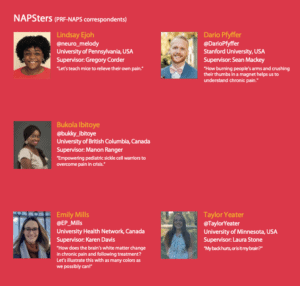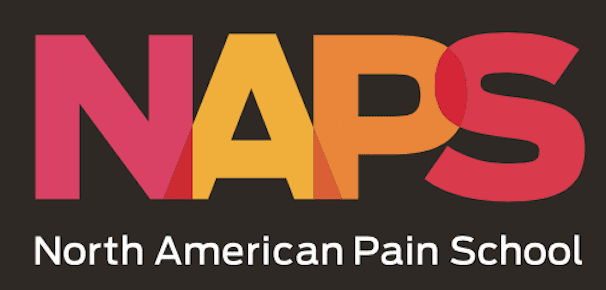Five early-career pain researchers are participating in the PRF-NAPS Correspondents program during the 2023 North American Pain School, taking place from 18-23 June in Montebello, Québec City, Canada. The Correspondents program is a unique science communication training program that provides participants with knowledge and skills needed to communicate science effectively to a wide range of pain researchers, patients, and the greater public. The Correspondents will conduct interviews with NAPS Visiting Faculty and Patient Partners, write summaries of scientific lectures – and provide live blogging too! Take a look at their blog posts from Day 3.
NAPS Day 3 Blog Posts
Science Communication about Science Communication
Can You Explain Your Research in Five Seconds?
In the United States, chronic pain is more prevalent than cardiovascular disease, cancer, and stroke – combined. However, pain is vastly overlooked when compared to these other prevalent health problems. If pain is so widespread and debilitating – why is it often an afterthought?

Perhaps it’s because you can’t “die of pain.” I’ve heard prolific pain researcher Allan Basbaum state, “You don’t die of pain – you die in pain.” Of course, one can feel so much agony that it leads to dangerous ideations, but pain itself cannot kill you.
If not death, what can pain bring? Some examples include poor mental health and sleep, the inability to participate in daily activities, stigmatization, the intense drive to seek drugs to relieve pain, and more (Phillips, 2009). Our bodies are hard-wired to avoid pain, so the cognitive dissonance that occurs when one is suffering and can’t do anything about it can be enough to drive a person mad.
To many, pain is not the fundamental issue, but signals a serious, underlying issue. As pain researchers, we know this can often not be the case. If people don’t see pain as an entity and a problem of its own, they won’t be motivated to fix it. It is our duty to spread the word to the general public to get taxpayers and politicians to seek solutions to pain, advocate for those living with pain, and work toward eliminating this plague to improve the lived experiences for billions of people globally.
Lindsay Ejoh is a PhD candidate at the University of Pennsylvania, USA. You can follow her on Twitter – @neuro_melody.
Image credit: Aaron Blanco Tejedor on Unsplash
Today, Anna Hood gave a powerful lecture titled, “Mechanism of Injustice: Acute-to-Chronic Pain Transition for Pediatric Patients Living with Sickle Cell Disease.” She highlighted the racism that people of color experience living with sickle cell disease.
Every person who’s experienced acute or chronic pain, regardless of its duration, wants it to end immediately. People in pain caused by sickle cell disease are no different.
In this study by Coleman et al., 2015, people living with sickle cell disease compared sickle cell crisis to burning with fire, hammering a bone in the body, and the effects of a poisonous scorpion sting.
Imagine this: Jack is setting up a bonfire by a lake. He’s alone and hoping to enjoy some quiet time. Mistakenly, his trousers catch fire. He’s trying to put it out, but it keeps spreading. He screams and the fire keeps spreading. Jack can’t swim. With nothing to fetch water, should Jack jump into the lake?
I can assure you – Jack will impulsively jump into the lake and then worry about drowning later. Just like Jack, people living with sickle cell disease are more worried about quenching the fire, not drowning.
A primary concern for many people living with sickle cell disease is to stop the pain, not the opioid dependence. Some clinicians are more concerned about the opioid dependence in people of color than supporting them through their current painful episode. Why is this the case?
Why are some people who explain their excruciating pain denied access to drugs and then labeled drug users?
Pain is subjective; hence, it can be argued and dismissed. No one argues with a thermometer. A “painometer” might be great, but it does not exist.
If it’s hurt, let’s focus on the pain. Not color. Not assumption. Not labels.
Bukola Ibitoye is a PhD candidate at the University of British Columbia, Canada. You can follow her on Twitter – @bukky_ibitoye.
Pain is the most common reason why an individual seeks medical care. Yet pain is rarely given the attention it deserves by society. Today, let’s dissect some of the reasons why.
Acute injuries are often associated with a visible marker of disability – as an example, we wear casts for broken bones. Society often assumes that if someone experiences pain, then it should be visible; otherwise, pain is an abstract experience that people find very difficult to understand.
There is an assumption that pain is a symptom of another underlying problem. If we treat the source of the pain, voilà! – the pain should go away, right? However, chronic pain is recognized as a disease entity in its own right, and for many people it is the primary medical issue. Pain deserves the attention that other conditions receive.
When chronic pain is the primary complaint, there’s often stigma associated with it. Pain can be comorbid with other mental health challenges including depression and anxiety, and is sometimes associated with substance addiction. In these situations, a simple assumption is that chronic pain is “all in your head.”
But even once these assumptions are dispelled, it leaves us with a difficult problem: Since biological, psychological, and social factors all influence pain, therein lies a question of where we focus our efforts to treat that pain. The multidisciplinary lens through which we need to view pain is a logistical nightmare when allocating funding resources and raising awareness.
Society largely overlooks pain because it isn’t always visible or immediately understandable. Together – as a pain research community spread across multiple disciplines – we can raise awareness of this issue and start to shift perspectives in society.
Emily Mills is a postdoctoral researcher at the Krembil Brain Institute, University Health Network, Toronto, Canada. You can follow her on Twitter – @EP_Mills.
Science Communication about Science Communication
The program for day three at NAPS included a workshop titled, “How to Write about Your Research to People without (and with) a Science Degree,” led by Pain Research Forum‘s very own Greg Carbonetti.
Seems quite ironic to write a blog post – which de facto is a part of science communication – about science communication.
Actually not! As PRF-NAPS Correspondents, some of us are still in the infancy of our science communication and writing skills, and many NAPSters have had little formal experience in this field.
Going a step further, I’d bet this is likely true for most young and aspiring pain researchers and the experts reading this blog post. Even if you are more advanced in your academic career and have professional skills in science communication, I assume a refresher about a few of the dos and don’ts won’t hurt, given the important role effective science communication plays in our daily lives.
First and foremost, avoid jargon – special words or expressions that are used in your field of expertise that might be very difficult for others to understand. It’s embedded in our science and daily conversations with our peers, and we’ve become immune to realizing how this appears to others outside our field.
While we should try to avoid using this technical language when writing for non-scientific audiences, we should be mindful not to exclude essential information. A lack of understanding can promote skepticism of pain science. Finding a balance between delivering your message and not oversimplifying is key for effective science communication.
Keep in mind, as long as you know whom you are writing for, focus on the story you aim to tell, and abstain from using your specific terms that sound like extraterrestrial language. You’ll be off to a good start infatuating and helping to educate your audience.
Dario Pfyffer is a postdoctoral research scholar at Stanford University, California, USA. You can follow him on Twitter – @DarioPfyffer.
Can You Explain Your Research in Five Seconds?
“Okay, clearly waffles are better than pancakes because once you add the syrup, pancakes just slide all over the plate. Waffles are much sturdier.”
“Does efficiency really matter in the selection of a dessert utensil? I like using forks more, but it may be more efficient to pick up the whipped cream with a spoon.”
At some point during every meal at NAPS, the conversation turns toward an intense debate focused on typically mundane food-related topics. In this particular moment, it was interesting to watch everyone jump into the conversation to share their thoughts, feelings, and past experiences with picking up whipped cream with a fork.
As scientists, we tend to have convoluted and nuanced conversations. We know so much about our specific research areas, and we love sharing our knowledge with others. When we do this all of the time, though, we can become immune to our use of jargon and superfluous explanations.
To address this, we had the pleasure of learning about science communication from Pain Research Forum’s Greg Carbonetti. His take-home message? “Pare, and prepare.”
In other words, simplify your message to the most important points and be prepared to deliver that information to any audience. No jargon!
He also left us with a challenge – explain your research in five seconds.
Taylor Yeater is a postdoctoral fellow at the University of Minnesota, USA. You can follow her on Twitter – @TaylorYeater.
The 2023 PRF-NAPS Correspondents



